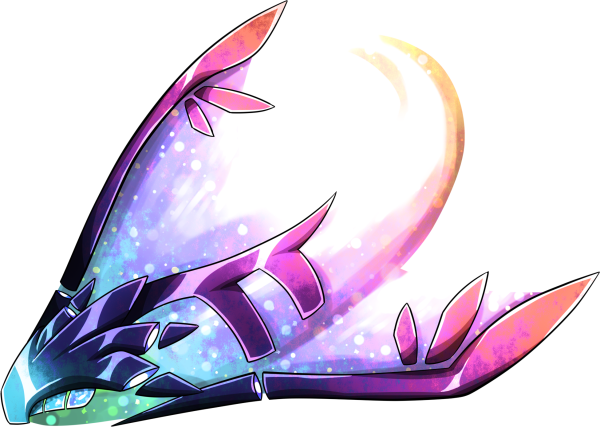| Species Info |
| Grouping: Elemental, Celestial |
| Rarity: Common |
| Time Per Stage: 22 Hours |
| Wild Caught: 9613 |
| Captive Bred: 451 |
| Total Population: 10064 |
Wild Caught Acquisition
Forested Laboratory — Found regularly at the Sector's nest.
Chroma Coast — Found regularly at the Sector's nest.
Crop Circle Canyon — Found regularly at the Sector's nest.
Galeful Marsh — Found regularly at the Sector's nest.
Common Chroma Breakdown
Rare Chroma Breakdown
Baby Stage Notes
This stone-like object has a glassy texture and a multicoloured lustre. It's remarkably lightweight for its size and seems to fall more slowly than other objects. Spikes on each side carry slit-like cracks which reveal a brightly glowing inner portion, but it doesn't seem to be hollow. This casts a faint light in dim conditions, but outright acts as a light source when it's completely dark.
Juvenile Stage Notes
The object turned out not to be an egg or a stone, but the headpiece of a baby creature. The newborn appears to be made of light and is very hot to the touch, making it difficult to handle without special gloves. The cracks on the headpiece merged shut shortly before the rest of the creature's body emerged, at which point the glassy surface became too hot to hold. Its hue ever-shifting, star-like particles appear suspended in its body in a glittering display. Though it appears aquatic and even moves through the air as if swimming, it hates the water and avoids being submerged; however, it appears to have no problem simply being near water. It seems most active at night and in low light levels.
Adult Stage Notes
Mobuluma are strange creatures commonly seen in the skies around the world, where they soar so high that they were previously believed to be passing comets. Almost strictly nocturnal, Mobuluma are most visible on clear nights in areas with little rainfall; they are instinctively phobic of water as it can damage the solid light energy that composes their bodies, and so have evolved to fly above the clouds to avoid rain.
Curious towards anything it deems to not be a threat, the Mobuluma glides lower to the surface of the planet to nest; its offspring splits off from the floating pieces of its exoskeleton and attaches to any sort of hidden cover it can find, to avoid rain and predators. Though the newborn carries cracks in its body to vent heat as it grows, once its exoskeleton has developed enough to protect it these cracks merge shut again and the energy pours out of the back, forming the body of the Mobuluma. As it reaches adulthood, more pieces of the armor develop and detach, slowing its growth by venting the heat again until it finally reaches adult size.
Mobuluma are vulnerable to any predator which uses water to hunt, or which is unaffected by the effects of intense heat and light. Thus, they avoid both diurnal and colourful predators, as evolution has generally lent itself towards these traits signifying a dangerous encounter for their species.

